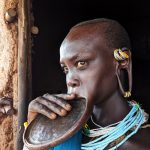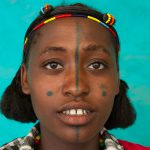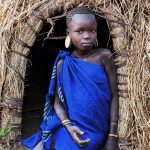The Kara/ Karo Tribe
January 13, 2022
The Kara tribe, historically regarded to have been the strongest and to form an important element in the political and economic system of the Lower Omo, occupying a key position in the web of trade routes that extended into today’s Kenya and South Sudan, has declined to be one of the smallest tribes along the river valley. Around 3000 Kara people live on the west bank of the Omo River in southern Ethiopia.
According to the oral tradition, they came to the present territory from a region south of the Sudan where a segment detached itself and came to the Omo Delta. Having formed the present day Dassanetch, a section of this segment again separated from the rest and continued in a northerly direction, establishing around the Woito River. Here again, having formed the group Marle, a section broke off and reached the Kara Land, the Dassanch and Marle, with whom the Karo affirm kinship relationships.
Today, the Kara people reside in three main villages: Labuk, Duss, and Korcho, from north to south, with some incredibly scenic and fertile farming regions intermingled with smaller hamlets. The kara’s major subsistence activity is flood-retreat agriculture, in which they plant crops like maize and sorghum, as well as beans and greens. Other subsistence practices include pastrialism, hunting, and gathering.
Kara speaks Kara-appo, a South Omotic language that is a dialect of Hamar and Banna. They refer to themselves and their region by the name “Kara.” They also adhere to the Hamar-bana religious rituals and practices. Beyond the acceptance of a creator and source of good fortune, barriyo lacks cosmology and focuses on curses and blessing rites. Sorcery and witchcraft are equally accepted and feared. The bitti, or religious leaders of the Kara, are responsible for maintaining communal well-being and resolving social and environmental issues.
The ritual life of kara is closely related to the rising and fall of the Omo River. The Omo River rises at irregular intervals from roughly January until around August, when water can even spill over the banks and pools can be discovered shockingly deep inland. This time of year, from February to August, is known as the “season of abundance, after the harvest People gradually leave their little hamlets near their farms and return to larger villages. Weddings and other major ceremonies are held, and there is time for relaxation, invites, and trade. The youths, who had been separated for a long period owing to hard labor in the fields, celebrate their reunion by dancing and festivities.
This harvest period is marked by numerous celebrations in Kara’s life where they dress up and adorn themselves. The Kara tribes are renown for the spectacular body painting they indulge in before important rituals or occasions. Colored ochre, white chalk, yellow mineral rock, charcoal, and flowers are used to create mostly nature-inspired patterns, ranging from simple lines to hand prints and striking animal motifs like leopards, or guinea fowl pluges. The Karo men plaster their hair into tight buns decorated with an ostrich feather, and create elaborate hairstyles and headdresses for themselves, signifying status, beauty, and bravery. The hairstyle favoured by Karo women is rather striking: tightly trimmed at the side, knotted into bulbous knots, and coloured ochre on top.
The Ukuli (bull jumping) boys’ age-rite ceremony is the biggest and most important ritual in the karo’s lives, signifying the boys’ transit to adulthood. Mr. Lale Labuko and the Kara elders have done an outstanding job of putting an end to the Minigi ritual in the Kara Tribe, which is an age-old superstitious ritualistic infanticide practiced by the Hamar, Bana, and Kara tribes that is still performed in remote hamar and bana communities.



